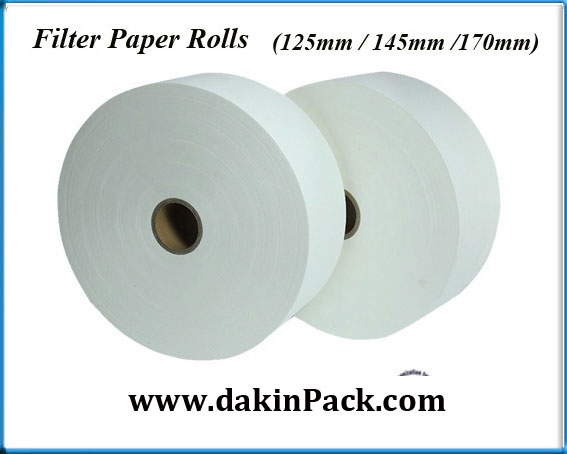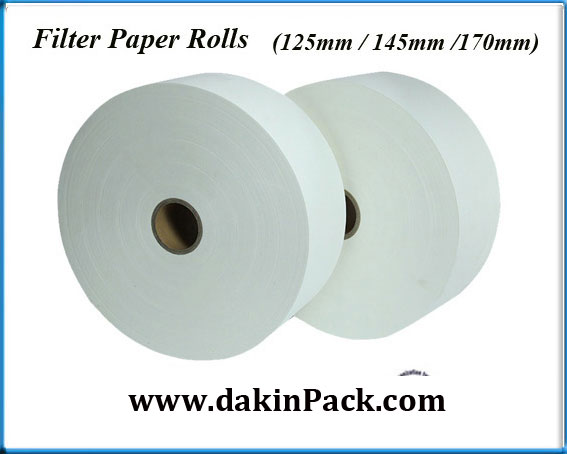Filter paper tea bag material
Tea bag filter paper material manufacturers and suppliers
DetailHeat seal tea bag filter paper packing material in Roll
Detail1. Maintain product quality and taste
When automatic packaging machines package coffee, tea and other products, they need to ensure the quality and taste of the products. As a filter material, filter paper can effectively remove impurities and residues in products and maintain the clarity and taste of the product. At the same time, filter paper can also prevent products from being contaminated during the packaging process and improve the hygienic quality of products.
2. Adapt to the needs of automated production
Automatic packaging machines need to use materials that can adapt to the needs of automated production. As a lightweight and easy-to-handle material, filter paper can well adapt to the needs of automated production. Filter paper can be used to easily put products into packaging bags, and automated equipment can be used for operations such as sealing and label printing to improve production efficiency.
3. Diversified specifications and shapes
Automatic packaging machines require the use of packaging materials of different specifications and shapes. As a flexible material, filter paper can produce packaging bags of different specifications and shapes to meet the packaging needs of different products. For example, round, square, flat and other different shapes of filter paper can adapt to the packaging needs of different products.
4. High mechanical strength and heat resistance
Automatic packaging machines need to withstand certain mechanical pressure and temperature during operation. As a material with high mechanical strength and heat resistance, filter paper can withstand certain mechanical pressure and temperature changes without cracking or deformation, ensuring the smooth progress of the packaging process.
5. Coffee and tea filter paper is economical and practical
Coffee and tea filters are still used mainly because of their practicality and affordability. First of all, filter paper can effectively remove impurities and residues in coffee and tea, improving the quality and taste of the product, which cannot be replaced by other alternative materials. Secondly, the production cost of filter paper is relatively low and the price is relatively affordable, making it suitable for widespread use. In addition, the filter paper also has good heat resistance and corrosion resistance, and can adapt to different cooking and baking needs.
Although filter paper has some shortcomings and limitations, such as easy clogging and not resistant to high temperatures, these shortcomings can be overcome by using suitable alternative materials or changing the way it is used. Generally speaking, coffee and tea filter paper is still a very practical and economical filter material, and it still has wide application prospects in the future.
5. Environmentally friendly and recyclable
The filter paper can be recycled and reused after use, which meets environmental protection requirements. Using filter paper can reduce environmental pollution and also reduce production costs.
In short, filter paper is suitable for automatic packaging machines, which can ensure the quality and taste of products, adapt to the needs of automated production, and has the advantages of diversified specifications and shapes, high mechanical strength and heat resistance, and environmental protection and recyclability. With the continuous development of automation technology, the application prospects of filter paper in automatic packaging machines will be broader.
The discovery and application of coffee and tea filter paper can be traced back to the early 20th century, when people began to use filter paper to improve the quality and taste of coffee and tea. The following is the discovery, application history and alternative materials of coffee and tea filters:
The discovery of coffee and tea filter paper
In the early 20th century, people began to use filter paper to filter impurities and residues from coffee and tea. Early coffee and tea filter papers were made of cellulose fibers, which had high filtration efficiency and low resistance, and could improve the quality and taste of coffee and tea. The emergence of these early filter papers solved the problems that people encountered when using cloth or other natural materials for filtration, such as easy clogging and difficulty in cleaning.
Application history of coffee and tea filter paper
Since the early 20th century, coffee and tea filters have been used in an increasingly wide range of applications. In the coffee field, filter paper is used to make espresso, hand-brewed coffee, ice-drip coffee, etc., which can remove impurities and residues and improve the quality and taste of coffee. In the field of tea, filter paper is used to make green tea, black tea, oolong tea, etc., which can remove impurities and residues in tea and improve the quality and taste of tea.
With the continuous advancement of technology and changing application requirements, the types and performance of coffee and tea filter papers are also constantly improving and improving. For example, some filter papers made of special materials can remove odors and bacteria in coffee and tea, improving the hygiene and safety of the products. In addition, some new nanomaterials and biomaterials have also begun to be used in coffee and tea filter papers to improve filtration efficiency and reduce resistance.
Alternative materials for coffee and tea filter paper
Although coffee and tea filters are widely used in many fields, they also have some disadvantages and limitations. Therefore, people have been looking for alternative materials to overcome these shortcomings, and biomaterials are being studied and may become alternative materials for coffee and tea filters in the future.
In short, the discovery and application history of coffee and tea filter paper has exceeded a century, and it has become an indispensable filter material in many fields. Although there are some shortcomings and limitations, with the continuous advancement of technology and changing application requirements, the performance and types of coffee and tea filter papers are also constantly improving and improving. At the same time, some alternative materials are also beginning to appear on the market, and may become important competitors for coffee and tea filters in the future.
Application Case of filter paper - V60 coffee filter bag
The V60 coffee bag is a paper filter bag used to hold coffee beans, and its use dates back to the early 20th century. At that time, people began to realize the importance of filter materials in the coffee brewing process, and began to use various types of filter materials, including cloth, silk, and linen. However, these materials have some disadvantages, such as being prone to clogging, not durable, and difficult to clean.
It was not until the 1960s that the Japanese company Hario introduced a coffee filter paper bag called V60, which completely changed the situation. The V60 coffee bag is a filter paper bag made of high-quality cellulose fiber with a unique honeycomb structure and excellent filtration performance. This filter paper bag can effectively remove impurities and residues from coffee beans while maintaining the original flavor and taste of coffee.
The emergence of the V60 coffee bag quickly gained recognition and favor from coffee lovers around the world, becoming an essential tool for making exquisite coffee such as hand-brewed coffee and ice-drip coffee. Over time, the use and influence of V60 coffee bags have expanded and they are now an integral part of coffee culture.
Thank you!



